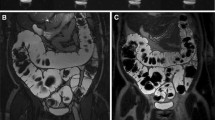Abstract
MRI of the small bowel is a new method for the assessment of inflammatory bowel diseases. However, inflammatory bowel disease can affect both the small and large bowel. Therefore, our goal was to assess the feasibility of displaying the small bowel and colon simultaneously by MR imaging. Eighteen patients with inflammatory bowel disease were studied. For small bowel distension, patients ingested a solution containing mannitol and locust bean gum. Furthermore, the colon was rectally filled with water. MR examinations were performed on a 1.5-T system. Before and after intravenous gadolinium administration, a T1w data set was collected. All patients underwent conventional colonoscopy as a standard of reference. The oral ingestion and the rectal application of water allowed an assessment of the small bowel and colon in all patients. By means of MRI (endoscopy), 19 (13) inflamed bowel segments in the colon and terminal ileum were detected. Furthermore, eight additional inflammatory lesions in the jejunum and proximal ileum that had not been endoscopically accessible were found by MRI. The simultaneous display of the small and large bowel by MRI is feasible. Major advantages of the proposed MR concept are related to its non-invasive character as well as to the potential to visualize parts of the small bowel that cannot be reached by endoscopy.






Similar content being viewed by others
References
Gore RM, Balthazar EJ, Ghahremani GG, Miller F (1996) CT features of ulcerative colitis and Crohn’s disease. Am J Roentgenol 167:3–15
Glickman RM (1991) Inflammatory bowel disease, ulcerative colitis and Crohn’s disease. Harrison’s principles of internal medicine, 12th edn. McGraw Hill, New York, pp 1268–1281
Low RN, Sebrechts CP, Politoske DA, Bennett MT, Flores S, Snyder RJ, Pressman JH (2002) Crohn disease with endoscopic correlation: single-shot fast spin-echo and gadolinium-enhanced fat-suppressed spoiled gradient-echo MR imaging. Radiology 222:652–660
Debatin JF, Patak MA (1999) MRI of the small and large bowel. Eur Radiol 9:1523–1534
Thoeni RF, Gould RG (1991) Enteroclysis and small bowel series: comparison of radiation dose and examination time. Radiology 178:659–662
Shoenut JP, Semelka RC, Magro CM, Silverman R, Yaffe CS, Micfli AB (1994) Comparison of magnetic resonance imaging and endoscopy in distinguishing the type and severity of inflammatory bowel disease. J Clin Gastroenterol 19:31–35
Lubolt W, Bauerfeind P, Wildermuth S, Debatin JF (1999) Contrast optimization for assessment of the colonic wall and lumen in MR colonography. J Magn Reson Imaging 9:745–750
Rieber A, Aschoff A, Nüssle K, Wruk D, Tomczak R, Reinshagen M, Adler G, Brambs H-J (2000) MRI in the diagnosis of small bowel disease: use of positive and negative oral contrast media in combination with enteroclysis. Eur Radiol 10:1377–1382
Umschaden HW, Szolar D, Gasser J, Umschaden M, Haselbach H (2000) Small bowel disease: comparison of MR enteroclysis images with conventional enteroclysis and surgical findings. Radiology 215:717–725
Gourtsoyiannis N, Papanikolaou N, Grammatikakis J, Prassopoulos P (2002) MR enteroclysis: technical considerations and clinical applications. Eur Radiol 12:2651–2658
Schunk K, Metzmann U, Kersjes W, Schadmand-Fischer S, Kreitner KF, Duchmann R, Protzer U, Wanitschke R, Thelen M (1997) Follow-up of Crohn’s disease: can hydro-MRI replace fractionated gastrointestinal passage examination? Rofo Fortschr 166:389–396
Lauenstein TC, Schneemann H, Vogt FM, Herborn CU, Rühm SG, Debatin JF (2003) Optimization of oral contrast agents for MR imaging of the small bowel. Radiology 228:279–283
Maglinte DD, Lappas JC, Kelvin FM, Rex D, Chernish SM (1987) Small bowel radiography: how, when, and why? Radiology 163:297–305
Lomas DJ, Graves MJ (1999) Small bowel MRI using water as a contrast medium. Br J Radiol 72:994–997
Minowa O, Ozaki Y, Kyogoku S, Shindoh N, Sumi Y, Katayama H (1999) MR imaging of the small bowel using water as a contrast agent in a preliminary study with healthy volunteers. Am J Roentgenol 173:581–582
Schunk K, Kern A, Oberholzer K, Kalden P, Mayer I, Orth T, Wanitschke R (2000) Hydro-MRI in Crohn’s disease: appraisal of disease activity. Invest Radiol 35:431–437
Patak MA, Froehlich JM, von Weymarn C, Ritz MA, Zollikofer CL, Wentz K (2001) Non-invasive distention of the small bowel for the magnetic-resonance Imaging. Lancet 358:987–988
Laghi A, Borrelli O, Paolantonio P, Dito L, Buena de Mesquita M, Falconieri P, Passariello R, Cucchiara S (2003) Contrast enhanced magnetic resonance imaging of the terminal ileum with Crohn’s disease. Gut 52:393–397
Hansmann HJ, Hess T, Hahmann M, Erb G, Elsing C, Richter GM (2001) MRI in chronic inflammatory bowel disease. Rofo Fortschr 173:4–11
Maccioni F, Viscido A, Broglia L, Marrollo M, Masciangelo R, Capri R, Rossi P (2000) Evaluation of Crohn’s disease with magnetic resonance imaging. Abdom Imaging 25:219–228
Gourtsoyiannis N, Papanikolaou N, Grammatikalis J, Papamastorakis G, Prassopoulos P, Roussomoustakaki M (2004) Assessment of Crohn’s disease activity in the small bowel with MR and conventional enteroclysis: preliminary results. Eur Radiol 14:1017–1024
Schmidt S, Lepori D, Meuwly J-Y, Duvoisin B, Meuli R, Michetti P, Felley C, Schnyder P, Melle G, Denys A (2003) Prospective comparison of MR enteroclysis with multidetector spiral-CT enteroclysis: interobserver agreement and sensitivity by means of “sign by sign” correlation. Eur Radiol 13:1303–1311
Lauenstein TC, Goehde SC, Ruehm SG, Holtman G, Debatin JF (2002) MR colonography with barium-based fecal tagging: initial clinical experience. Radiology 223:248–254
Author information
Authors and Affiliations
Rights and permissions
About this article
Cite this article
Narin, B., Ajaj, W., Göhde, S. et al. Combined small and large bowel MR imaging in patients with Crohn’s disease: a feasibility study. Eur Radiol 14, 1535–1542 (2004). https://doi.org/10.1007/s00330-004-2364-7
Received:
Revised:
Accepted:
Published:
Issue Date:
DOI: https://doi.org/10.1007/s00330-004-2364-7




